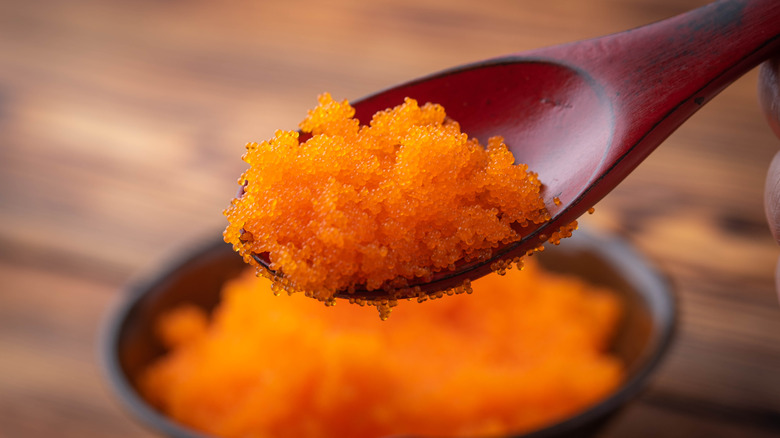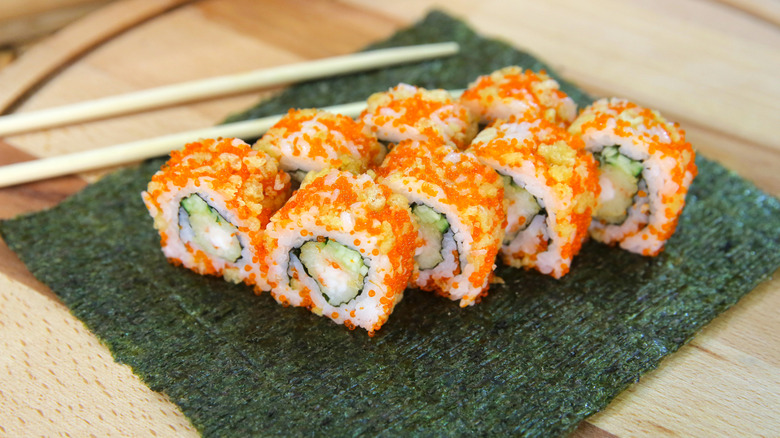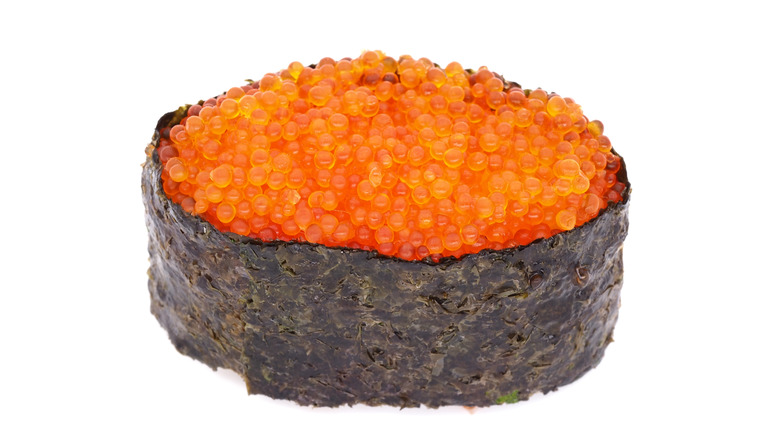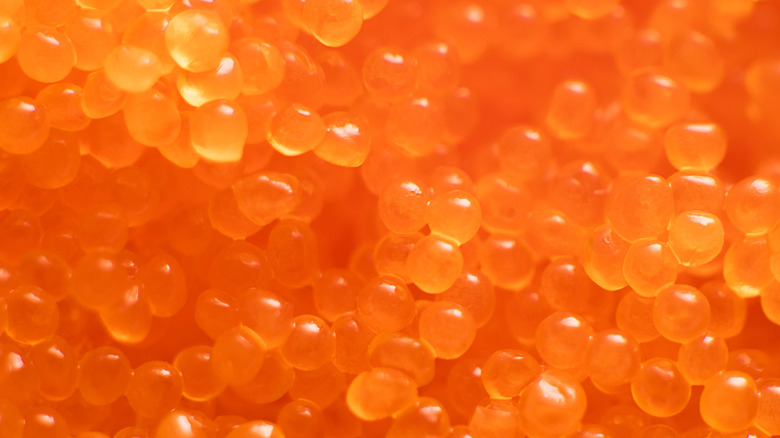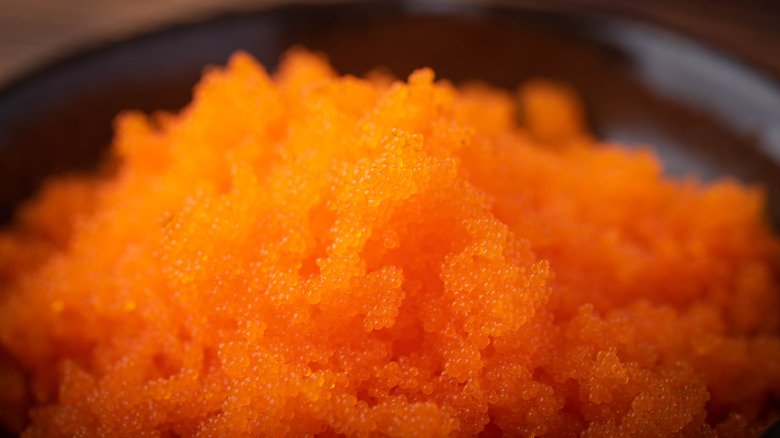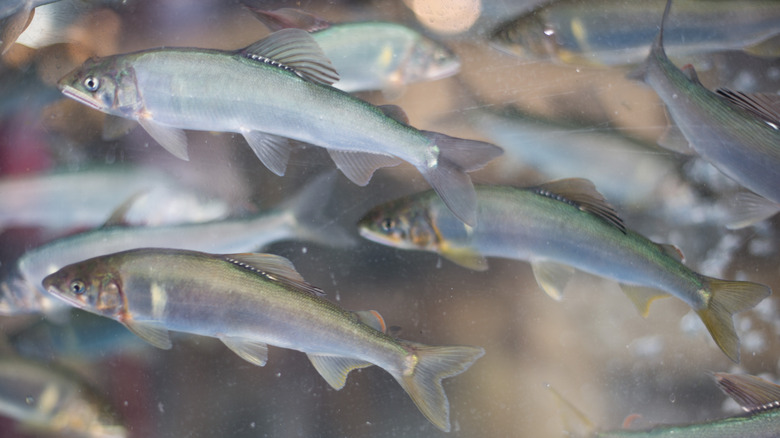What Is Masago And What Does It Taste Like?
Have you ever had sushi and wondered about the origins of those tiny orange spheres that adorn various types of rolls? They're called masago, and are a trademark ingredient in not only Japanese cuisine, but many different food cultures worldwide. While they may not offer as much of the flavor or textural component of lobster, shrimp, yellowtail, nori, or rice, they're invaluable, and a cherished ingredient for many.
The Kitchn notes that masago is capelin roe, which are eggs from the capelin fish, a type of smelt. Healthline defines roe as the "fully ripened eggs of many types of fish," and also notes that capelin, or smelt, look similar to sardines. How Daily states that masago actually means "sand" in Japanese, which is a reference to the roe's diminutive size.
Masago is characterized by its bright, vibrant orange hue. Capelin is often found in arctic waters across various oceans, and their roe is miniscule — only about one millimeter in diameter, according to Izzy Cooking.
What does masago taste like?
From a flavor perspective, masago has a briny, salty note that can be slightly bitter and subtly fishy. It has a rather high sodium content, which is evident once you taste it. Of course, it is raw. It certainly contributes a slight crunch to whatever it is added to, but it doesn't have the trademark "pop" that caviar often delivers. Masago also naturally clumps together, so the slight crunch it offers is often multiplied when someone bites into a whole cluster of masago at once.
The Japanese Bar states that masago is "softer" than tobiko and is "slightly sweet, briny, and with a bit of a citrusy quality." Furthermore, there are different types: orange, black, red, and wasabi. Each have the same base ingredient, but the different variants include certain additions in order to subtly change the color or flavor of the masago itself.
How is masago used?
In addition to myriad sushi rolls, it's also great with fish in any capacity (cooked dishes, sashimi, and so on), as well as with vegetables and all kinds of rice in different appetizers, meals, and side dishes. Masago often acts as a garnish or is sometimes mixed with condiments or sides to act as dipping sauces, says Izzy Cooking. Of course, its trademark color also adds variety and brightness beyond just the flavor and textural components. While not always used with sushi, though, masago is almost always paired with another seafood.
The Japanese Bar notes that many drink shochu, wine, sake, and beer with sushi — and therefore, with masago. The briny, salty notes of masago tend to pair well with those libations. The site also notes that masago and tobiko, another type of roe, freeze well, so they are beneficial ingredients because they can be used year round.
Is masago naturally orange?
Masago's trademark color is actually manmade. The tiny eggs are dyed to make them more aesthetically appealing. Isn't it strange that one of the trademark properties of masago is actually not inherent? In actuality, the natural color of masago is much more lackluster and ordinary, usually more of a pale yellow (via Izzy Cooking).
While there are many types of fish roe often used in Japanese cuisine, the two most prominent are certainly tobiko and masago. While tobiko is more ubiquitous in Japan, masago is more often used in the U.S. Masago may be sometimes conflated with tobiko, but the latter is considerably larger and often green, so it's quite simple to differentiate between them. Nor do both come from the same source. Tobiko is the roe of flying fish, and is also much more expensive, so many Japanese restaurants tend to opt for masago because of its price point and because the flavor disparity isn't too extreme (via Sushi FAQ).
Is masago good for you?
Nutritionally, masago is very low in calories and offers omega-3 fatty acids, multiple vitamins, magnesium, and selenium. You can purchase it online, at Asian markets and grocery stores, or some supermarkets, according to Izzy Cooking. It's also especially high in vitamin B12, amino acids, protein, and much more. It's also low in mercury, but obviously very high in sodium (via Healthline). The Japanese Bar also notes that masago and tobiko are both gluten-free.
Most commercial masago is also "cured with many ingredients," according to The Japanese Bar, which notes that "soy sauce, MSG, high fructose corn syrup, and food coloring agents" are all added in most instances. As noted, while these are less than ideal, unless you're eating copious amounts of sushi or masago, there is really no cause for concern. Of course, if you do have a sensitivity to sodium, it may be wise to steer clear of the tiny orange spheres.
Is masago sustainable?
Masago is a contested topic from a sustainability perspective.
While it's noted that capelin is relatively sustainable and the population is quite high worldwide, there are also concerns about overproduction due to the fact that more female fish are "targeted" in order to meet the need for masago, which has affected the gender disparity breakdown of the fish species over time, according to Healthline. Furthermore, flying fish or capelin are susceptible to overfishing, according to The Japanese Bar, and changes in population and location from season to season can affect fishing and harvesting, as well as additional environmental changes.
However, there are certain companies or fisheries that are intent on sustainable fishing, such as the ISF — or Iceland Sustainable Fisheries — which is certified as a "sustainable and well-managed fishery" which is respectful and mindful of "[capelin's]' pivotal role in the ecosystem," as noted by this press release. We hope more fisheries worldwide follow in their footsteps.
The long-term, environmental concerns are certainly something to mull over the next time you indulge in sushi.
